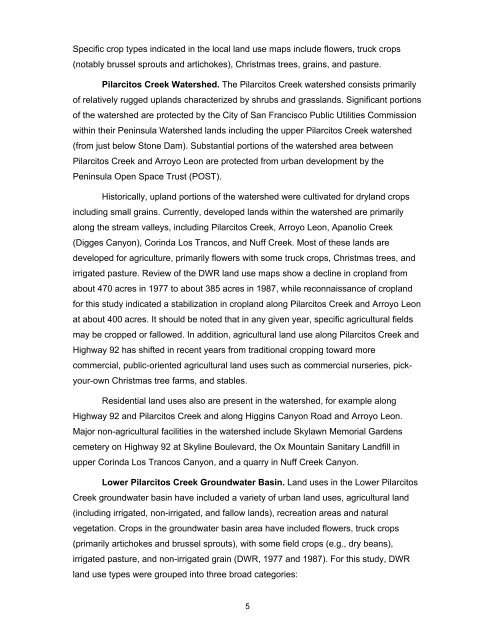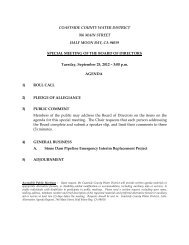Lower Pilarcitos Creek Groundwater Basin Study - Coastside ...
Lower Pilarcitos Creek Groundwater Basin Study - Coastside ...
Lower Pilarcitos Creek Groundwater Basin Study - Coastside ...
Create successful ePaper yourself
Turn your PDF publications into a flip-book with our unique Google optimized e-Paper software.
Specific crop types indicated in the local land use maps include flowers, truck crops<br />
(notably brussel sprouts and artichokes), Christmas trees, grains, and pasture.<br />
<strong>Pilarcitos</strong> <strong>Creek</strong> Watershed. The <strong>Pilarcitos</strong> <strong>Creek</strong> watershed consists primarily<br />
of relatively rugged uplands characterized by shrubs and grasslands. Significant portions<br />
of the watershed are protected by the City of San Francisco Public Utilities Commission<br />
within their Peninsula Watershed lands including the upper <strong>Pilarcitos</strong> <strong>Creek</strong> watershed<br />
(from just below Stone Dam). Substantial portions of the watershed area between<br />
<strong>Pilarcitos</strong> <strong>Creek</strong> and Arroyo Leon are protected from urban development by the<br />
Peninsula Open Space Trust (POST).<br />
Historically, upland portions of the watershed were cultivated for dryland crops<br />
including small grains. Currently, developed lands within the watershed are primarily<br />
along the stream valleys, including <strong>Pilarcitos</strong> <strong>Creek</strong>, Arroyo Leon, Apanolio <strong>Creek</strong><br />
(Digges Canyon), Corinda Los Trancos, and Nuff <strong>Creek</strong>. Most of these lands are<br />
developed for agriculture, primarily flowers with some truck crops, Christmas trees, and<br />
irrigated pasture. Review of the DWR land use maps show a decline in cropland from<br />
about 470 acres in 1977 to about 385 acres in 1987, while reconnaissance of cropland<br />
for this study indicated a stabilization in cropland along <strong>Pilarcitos</strong> <strong>Creek</strong> and Arroyo Leon<br />
at about 400 acres. It should be noted that in any given year, specific agricultural fields<br />
may be cropped or fallowed. In addition, agricultural land use along <strong>Pilarcitos</strong> <strong>Creek</strong> and<br />
Highway 92 has shifted in recent years from traditional cropping toward more<br />
commercial, public-oriented agricultural land uses such as commercial nurseries, pickyour-own<br />
Christmas tree farms, and stables.<br />
Residential land uses also are present in the watershed, for example along<br />
Highway 92 and <strong>Pilarcitos</strong> <strong>Creek</strong> and along Higgins Canyon Road and Arroyo Leon.<br />
Major non-agricultural facilities in the watershed include Skylawn Memorial Gardens<br />
cemetery on Highway 92 at Skyline Boulevard, the Ox Mountain Sanitary Landfill in<br />
upper Corinda Los Trancos Canyon, and a quarry in Nuff <strong>Creek</strong> Canyon.<br />
<strong>Lower</strong> <strong>Pilarcitos</strong> <strong>Creek</strong> <strong>Groundwater</strong> <strong>Basin</strong>. Land uses in the <strong>Lower</strong> <strong>Pilarcitos</strong><br />
<strong>Creek</strong> groundwater basin have included a variety of urban land uses, agricultural land<br />
(including irrigated, non-irrigated, and fallow lands), recreation areas and natural<br />
vegetation. Crops in the groundwater basin area have included flowers, truck crops<br />
(primarily artichokes and brussel sprouts), with some field crops (e.g., dry beans),<br />
irrigated pasture, and non-irrigated grain (DWR, 1977 and 1987). For this study, DWR<br />
land use types were grouped into three broad categories:<br />
5



